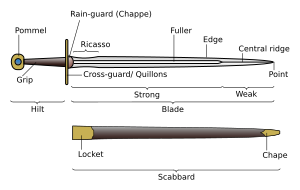Crossguard facts for kids
A crossguard is a special part of a sword that helps protect the user's hand. It's a metal bar placed between the sword's blade and its hilt (the handle). Think of it like a shield for your hand!

Contents
History of the Crossguard
Crossguards first appeared on European swords around the 10th century. Before this, swords didn't offer much hand protection. Some of the earliest examples of crossguards can be found on ancient Persian swords from the 3rd century.
Later, crossguards became common on late Viking swords. They were a standard feature on Norman swords in the 11th century. Knights also used them on their arming swords throughout the Middle Ages.
Early crossguards were simple, straight metal bars. Sometimes they got thinner towards the ends. Even though more fancy designs came along, this simple style was always used. In the 12th and 13th centuries, crossguards could be curved or bent in the middle.
Why Swords Have Crossguards
The main reason for a crossguard is to protect the sword user's hand. It stops an enemy's blade from sliding down your sword and cutting your fingers.
But crossguards also helped in other ways. They could be used to block or trap an enemy's blade. They also gave the user a better grip on the sword, making it easier to control during a fight.
Different Styles of Crossguards
From the 13th or 14th century, many swords had a piece of leather called a "chappe" or "rain-guard" attached to the crossguard. We're not entirely sure why this was used. It might have been part of the scabbard (the sword's sheath), acting like a lid when the sword was put away.
In the 14th and 15th centuries, sword makers tried many new and detailed crossguard designs. Some had a small bump in the middle where the crossguard met the blade. Sometimes, the leather chappe was replaced with a metal sheet. An example of this is a sword from the early 15th century, where the rain-guard was made of silver and decorated with flowers.
After the Middle Ages, crossguards became even more complex. They developed into "quillons" and then into "guard branches." These branches eventually formed a "basket hilt." A basket hilt offered even more protection to the hand, especially when knights stopped wearing full armor.
Crossguards on Daggers
Medieval daggers in the 14th and 15th centuries also started to have crossguards, similar to those on swords. These daggers with crossguards remained popular in the 16th century, even after the sword styles they copied were no longer widely used.
Images for kids
See also
 In Spanish: Cruceta (espada) para niños
In Spanish: Cruceta (espada) para niños



